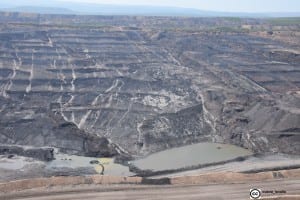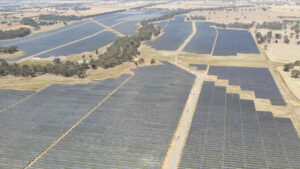
South32, the company spun off by BHP Billiton in 2015, has decided thermal coal is so threatened by renewables and unloved by investors it plans to offload its four South African coal mines. Once the sale is completed, South32 will be all done with thermal coal.
Like South 32, BHP has faced a strategic choice: milk their thermal coal mines for cash for as long as possible and endure public and investor criticism or make an orderly exit from the controversial commodity and buff its climate credentials. BHP went for the cash.
As a result BHP not only remains mired in controversy over its plan to expand a massive coal mine in Colombia but also over its continued membership of coal lobby groups advocating policies at odds with the Paris Agreement goals.
“Thermal coal isn’t for us,” South32’s CEO Graham Kerr recently told [paywall] The Australian, warning that rapid changes in the energy market were making the medium- to long-term viability of mines far less certain.
While arguing thermal coal has a role in the power mix for a while, Kerr said that both he and South32 “believe in climate change and that over time the world does need to decarbonise.”
South32’s shift has been building for some time.
In its climate statement released last year, the company sketched three possible policy paths, one of which it dubbed the “global cooperation” scenario, based on limiting global warming to an increase of two degrees or less.
For its South African coal assets, the company stated (p.16):
“Public acceptance of energy coal continues to diminish, with climate change and concerns around the impact of air pollution on public health making it politically risky to support new energy coal power stations or mines.
Although CCS [carbon capture and storage] is used in the global cooperation scenario, with some plants fitted with the technology by 2025, it is deployed much more slowly than renewables, reducing energy coal’s ability to take part in the transition to a low carbon future. As a result, the seaborne trade for energy coal would continue to decline to 2040.”
While South32’s shift away from thermal coal has been wrapped in a veneer of climate concern, the company has no intention of ensuring its coal assets aren’t mined. Rather, it simply wants to offload them before coal’s decline accelerates further, undermining the viability of coal, particularly in the global export market.
South32 — along with other mining companies in South Africa — are also under increasing pressure to sell majority stakes in their businesses to comply with the Black Economic Empowerment program to address the economic inequality created under the apartheid regime.
BHP’s wrong turn
Back in November 2017 South32 announced it would shift its South African thermal coal operations into a standalone company prior to selling the company off via a sharemarket float.
South32 produced 16.7 million tonnes of coal for Eskom in 2017 and exported a further 12.2 million tonnes that year. The company also holds a 21 per cent stake in the Richards Bay Coal Terminal.
To sweeten the deal for potential buyers, South32 announced that it will invest US$301 million in extending the life of the Klipspruit mine by 20 years. The company’s four thermal coal mines, which supply Eskom power plants, have been valued at just US$59 million.
However, South32 plans to hold onto its two underground metallurgical coal mines in the Illawarra region of New South Wales. (Both mines — Appin and Dendrobium — have been embroiled in controversies over pollution and the impact on Sydney’s drinking water catchments.)
When in August 2014 BHP Billiton (as it was at the time) announced it planned to spin off a motley collection of many of its worst-performing assets to a new company which it temporarily dubbed “NewCo”, many financial market analysts and commentators were underwhelmed by the prospects for the new company.
While BHP Billiton soon after named the new company South32, others had different ideas. “Some of the unhelpful names we got after we demerged from BHP for a while was SpinCo, CrapCo and ShitCo,” Kerr said later [paywall].
At the time, BHP decided it wanted to hang onto its two most profitable coal mines, the Mt Arthur mine in the Hunter Valley in New South Wales and its one-third share in the Cerrejon mine in Colombia. (Two other companies — Anglo American and Glencore — also hold one-third shares.)
Between them the two mines currently produce almost 29 million tonnes of thermal coal a year, overwhelmingly for the global market.
While BHP has proclaimed its support for the Paris Agreement, it and its joint venture partners are pressing ahead with plans to expand production of the Cerrejon mine from 33 million tonnes a year to about 40 million tonnes a year. The three owner companies invested US$1.3 billion in expanding the capacity of its port operations but, despite being commissioned in late 2014, the expanded operations have been little used due to adverse weather and other factors.
While seeking to promote its climate credentials, BHP remains stuck with two big thermal coal mines at a time when the commodity is increasingly unpopular with investors, the public and climate policy makers.
Between the Cerrejon and Mt Arthur mines, BHP controls two deposits that contain potentially well over 1.4 billion tonnes more thermal coal that could be mined, depending on the prevailing global prices.
In August last year, BHP informed investors the mines were the fourth and fifth most profitable projects amongst their diverse portfolio of mines around the world.
As momentum away from thermal coal has grown, BHP faced a choice: it could cap its thermal coal production by not expanding the Cerrejon mine as part of a strategy of eventually exiting any role in producing the much-maligned commodity; or it could go for the short-term cash flows and hope to avoid too much public scrutiny.
BHP went for the cash but it hasn’t worked out well for the company.
Where South32 has moved to divest itself from thermal coal, BHP is increasing its exposure through the expansion of Cerrejon, which is one of the world’s biggest coal mines.
For its climate sins BHP faces ongoing scrutiny as the contradiction grows between its expressed support for the Paris Agreement and its continued membership of coal-boosting industry lobby groups such as the World Coal Association (WCA) and the Minerals Council of Australia.
Meanwhile, South32 — which is not a member of the WCA — is making the most of its thermal coal exit as an opportunity to burnish its limited climate credentials.
Bob Burton is the Editor of CoalWire, a weekly bulletin on global coal industry developments. (You can sign up for it here.) Bob’s Twitter feed is @BobBurtonoz.










